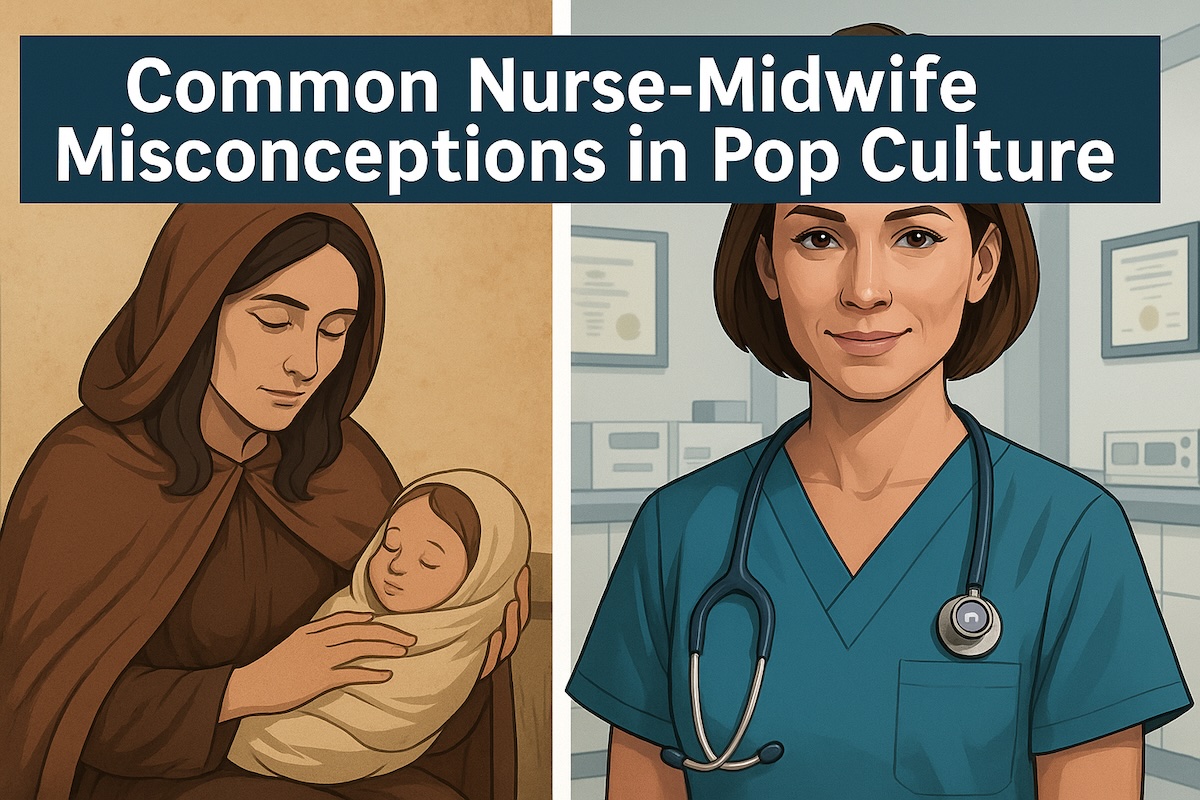How Pop Culture Skews Our View of Nurse-Midwives
Pop culture often reinforces inaccurate or outdated ideas about midwifery. Whether it’s a TV drama or comedy sketch, nurse-midwives are sometimes portrayed as mystical healers, fringe birth assistants, or obsolete relics of a pre-medical past. These portrayals do little to reflect the clinical training, licensure, and responsibility of Certified Nurse-Midwives (CNMs) in the healthcare system.
From The Mindy Project to Call the Midwife and Virgin River, midwives are portrayed in comedic to overly romanticized roles. Unfortunately, these narratives rarely show the full scope of what CNMs do, managing pregnancy, delivering babies, prescribing medication, and providing lifelong gynecologic care.
Three Big Misconceptions About Nurse-Midwives
Misconception 1: Midwives Aren’t Real Medical Professionals
One of the most persistent myths is that midwives are unlicensed or operate outside the formal healthcare system. In truth, CNMs are licensed Advanced Practice Registered Nurses (APRNs) with graduate degrees, certified by the American Midwifery Certification Board (AMCB). They often collaborate with OB-GYNs and are authorized to practice in all 50 states.
Misconception 2: Midwives Only Attend Home Births
Thanks to overused bathtub birth scenes in movies, many people think midwives only handle out-of-hospital births. In reality, most CNMs work in hospitals and clinics. They can also practice in birth centers or attend home births, but always within the bounds of state law and professional guidelines.
Misconception 3: Nurse-Midwives and Doulas Are the Same
Pop culture often confuses nurse-midwives with doulas. While doulas provide emotional and physical support during labor, CNMs are licensed clinicians who provide medical care, monitor fetal health, diagnose conditions, and even prescribe medications.
CNM vs. CPM vs. Doula: What’s the Difference?
| Role | Education | Certification | Scope |
|---|---|---|---|
| Certified Nurse-Midwife (CNM) | MSN or DNP in Nursing | AMCB | Medical care, prescribing, and delivery |
| Certified Professional Midwife (CPM) | Midwifery-specific pathway | NARM | Community-based birth care |
| Doula | Workshop or training | Optional; not licensed | Labor support, non-clinical role |
Gender Stereotypes and Midwifery
Another common assumption is that all midwives are women. While the field is predominantly female, many men are becoming CNMs. These providers help expand access and diversity in maternal healthcare. The American College of Nurse-Midwives (ACNM) supports inclusivity in the profession and offers guidance for aspiring male CNMs.
The Real Impact of Misconceptions
These cultural myths don’t just misinform, they influence public policy and insurance coverage. Misunderstandings about midwifery have historically limited practice rights and affected Medicaid reimbursement in certain states. Today, nurse-midwives are working to expand recognition and access across the U.S.
Want to Become a Nurse-Midwife?
Visit our career guide or check out midwife licensing requirements by state to get started.
Frequently Asked Questions About Nurse-Midwives
Are nurse-midwives licensed medical professionals?
Yes, Certified Nurse-Midwives (CNMs) are licensed advanced practice registered nurses who have completed graduate-level training and are certified by the AMCB.
Can nurse-midwives prescribe medications?
In most U.S. states, CNMs have full prescriptive authority, allowing them to prescribe drugs and manage care independently.
What’s the difference between a CNM and a CPM?
CNMs are nurses with graduate-level midwifery training who work in clinical and hospital settings. CPMs usually follow an apprenticeship path and practice at home or in birthing centers.
Do nurse-midwives only assist with childbirth?
No, they provide full-spectrum women’s healthcare, including gynecological exams, prenatal care, postpartum support, and family planning services.
Is it safe to have a baby with a nurse-midwife?
Yes. Research shows that births attended by CNMs result in comparable or better outcomes than physician-led deliveries, especially for low-risk pregnancies.





